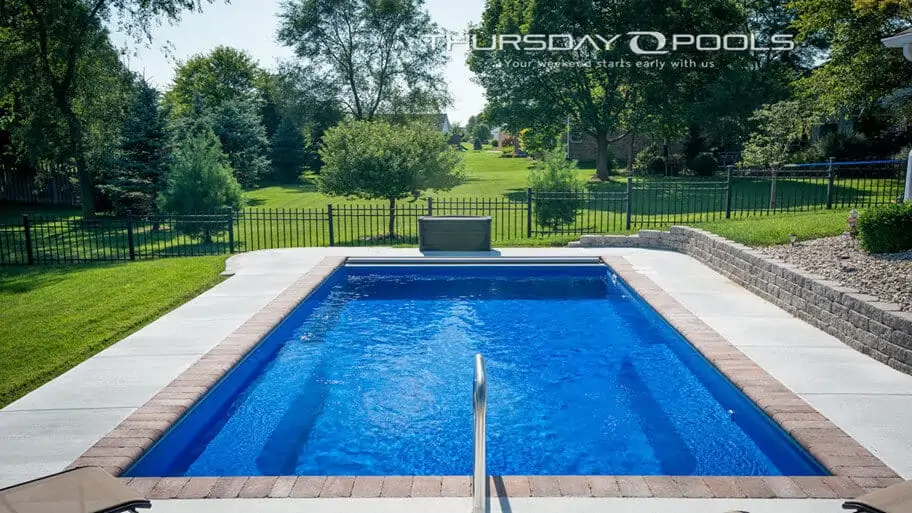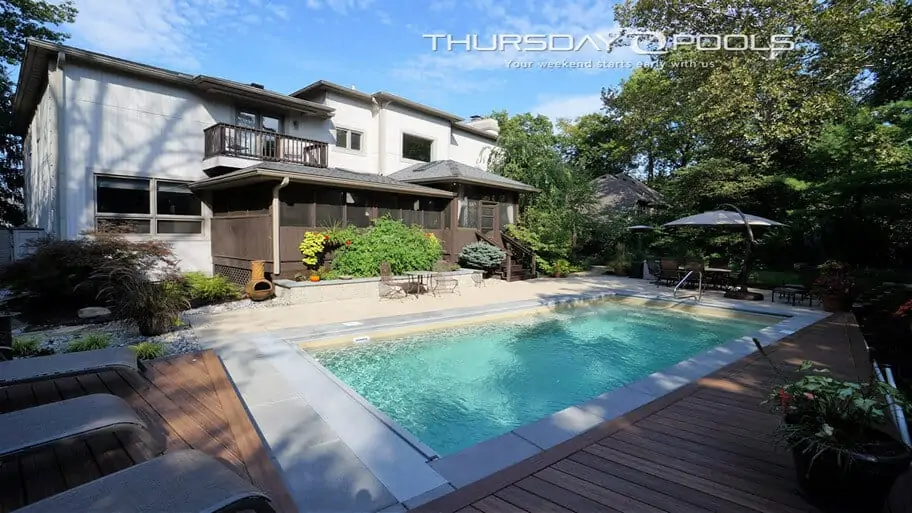You’ve probably heard of fiberglass pools. You probably know what they look like (especially if you’re reading this). And you probably know that they’re an expensive investment, as all pools are.
But how much do you really know about fiberglass pools?
Do you know how they’re manufactured? Do you know what you have to do to maintain them? Do you know the great and not-so-great things about them?
Well, if not you’re in luck!
At Royal Pools and More, we specialize in installing fiberglass pools for over 15 years and consider ourselves top experts on them. So, we’re here to answer all of your questions about fiberglass pools before you make the investment that will hopefully bring you decades of fun and enjoyment!
We’re going to cover some of the pros and cons of fiberglass pools as well as the extensive manufacturing process that creates a strong and durable structure.
So let’s get started!
Manufacturing Process
Fiberglass pools are the only type of pool constructed off-site and then transported to their respective locations; both vinyl liner and concrete pools are constructed in their final location. As so, there is an extensive process by which fiberglass pools are manufactured.
Here is the step-by-step process that our manufacturers follow when building a fiberglass pool:
1. The Plug
The manufacturing process begins with the plug—an exact replica of a fiberglass pool shape. This is made of wood or steel, fiberglass, body filler, and primer. Manufacturers will have plugs for each type of fiberglass pool that they offer and if they don’t (or if they’re building a new pool shape), they’ll have to build the plug first.
2. The Mold
From the plug, the mold will be built, which is the pool shell that will be installed in your backyard. Think of it like this: the plug is a template around which the mold is built. Keep in mind these two things: the mold is built around the plug, not inside and many layers make up the final product.
3. The Gelcoat
The first layer of the pool is the gel coat (colored resin) which is what you see as the surface of the pool. You can choose from a variety of colors for the gel coat, but all are constructed in the same manner. The colored resin is applied through a spray gun in three separate layers to ensure that it is as strong and durable as possible.
4. Vinyl Ester Resin
After the gel coat comes the vinyl ester resin. This is needed since the gel coat is semi-permeable, which means that water can pass through it in certain areas. Thus, the vinyl ester resin acts as a barrier between the remaining layers to prevent water from seeping through.
5. Chopped Fiberglass
After the vinyl ester resin, two layers of chopped fiberglass are applied to the mold. The chopped fiberglass is made of polyester resin, chopped fiberglass roving, and a catalyst. These materials work together to reinforce the pool shell with two layers of strength and durability. After the first layer is applied, it is rolled using rollers to smooth it out and prevent air bubbles. The same process is done after the second layer is applied.
6. Woven Roving Fiberglass
After the two layers of chopped fiberglass comes a layer of woven roving fiberglass. This is not a full layer, but rather a material used to reinforce areas such as corners and where the pool wall meets the pool floor. This is done to eliminate thin spots around the shell where there is a lack of fiberglass. In other words, this material is applied to make sure the pool is well-reinforced where necessary.
7. Chopped Fiberglass
Once the woven roving fiberglass is applied, another layer of chopped fiberglass is applied for strength purposes and then rolled once again to smooth it out.
8. Honeycomb Core
After the third layer of chopped fiberglass comes the honeycomb core which comes in vertical strips and is placed along the walls of the mold. This is added for structural support and to reduce the flexibility of the fiberglass layers that have come before it.
9. Chopped Fiberglass
To finish the manufacturing process, two more layers of chopped fiberglass are applied and the same procedures are followed as they are with the other layers.
So as you can see, fiberglass pools are more complex than you may think. There is great attention to detail in each layer of the structure to make sure that it will be able to last a lifetime.
Pros of Fiberglass Pools
Easy to Maintain
One of the features that have made fiberglass swimming pools so popular in recent years is how little you must do to maintain them. This is all thanks to the surface of a fiberglass pool, known as the gel coat.
The gel coat is the surface that you see of a fiberglass pool and is non-porous, meaning it is smooth and has no pores where algae can grow. Therefore, the pool does not need to be thoroughly cleaned as frequently compared to a concrete pool.
The gel coat also aids in keeping the water chemistry balanced as it doesn’t affect the pH level of the water like the surface of concrete pools does. Now, you’ll still have to regularly check on the pH level and add chemicals if it needs to be balanced, but it tends to be required less than concrete pools if maintained properly. And, not to mention, you get an added benefit too: you won’t need to pay for cleaning services like you’d have to with concrete pools.
Considering these advantages, fiberglass pool owners spend more time enjoying their pool than ensuring it is well-maintained.
Installation Time
Probably one of the best pieces of news for you about fiberglass pools is that their installation time is fairly quick! They have the quickest installation time out of all three types of pools!
It usually takes between 3-4 weeks to complete the installation process. While the shell is installed over two days, decking, landscaping, and other construction make up the additional installation time.
When considering the additional weeks it takes to install a vinyl liner pool and the additional months it takes to install a concrete pool, fiberglass pools come out on top in the race to completion.
Durability
Strength and durability are what fiberglass pools pride themselves on. The layering process that we previously described is extremely intricate and extensive to ensure that the structure can last a lifetime if taken care of well.
Unlike vinyl liner pools, a fiberglass pool does not have a liner that must be replaced every 4-9 years so the cost of $4,000-5,000 per liner is eliminated. Cracks are also not an issue that needs to be fixed as they are in the vermiculite flooring of fiberglass pools.
With the smooth gel coat surface instead of a liner, it is much more difficult to puncture the surface of a fiberglass pool through daily use. Therefore, there is no need to worry as much about animals or other foreign objects damaging the pool.
So yes, the initial cost (which we’ll get to soon) of fiberglass pools is more expensive, but you’re receiving a more durable product that can withstand much more.
Lifetime Cost
Several costs that need to be factored in during the lifetime of vinyl liner and concrete pools are eliminated with fiberglass pools. For example, replacement liners, cleaning services, and heavy chemical usage is not a factor when you own a fiberglass pool.
So, as we’ve said, the initial cost is a bit more expensive, but you make up for it in the lack of maintenance costs!
Cons of Fiberglass Pools
Initial Cost
As we’ve noted, the initial cost of fiberglass pools is a bit more expensive than vinyl liner pools. But they are slightly less expensive than concrete pools with a range of $60,000–$90,000. And for more specificity, we break down price ranges into categories like this:
- Small Fiberglass Pools (10’ x 20’ – 13’ x 27’): $60,000 – $70,000
- Medium Fiberglass Pools (13’ x 28’ – 16’ x 32’): $70,000 – $80,000
- Large Fiberglass Pools (16’ x 33’ – 16’ x 41’): $80,000 – $90,000+
So yes, they may be a bit more pricy, but the majority of the lifetime cost will consist of the initial cost of the pool.
Customization
While we do offer a variety of fiberglass pool designs in different shapes and sizes, it is not possible to customize the design if you cannot find one that fits your wants and needs. And if you cannot find a perfect fiberglass pool for you, maybe a vinyl liner or concrete pool is a better option.
However, 90% of people do find a fiberglass pool that does meet all of the criteria they are looking for.
What Else Should You Know?
Ok, you can breathe a sigh of relief now! We know that we just threw a lot of information at you about fiberglass pools! But honestly, it’s all information that you need to know to make an informed decision on which pool is right for you,
Perhaps it’s a vinyl liner pool. Or maybe it’s a concrete pool. To make the best decision for you and your family, you’ll have to know what each type of pool has to offer and what their drawbacks are.
So, you can keep learning by visiting our learning center or some of the articles listed below!





